Rolling Stock of the Epping Ongar Railway
This article is about the Rolling stock of the Epping Ongar Railway.
Steam Locomotives [1]
| Number and name |
Origin |
Wheel
arrangement |
Class |
Notes |
Photograph |
| 4141 |
GWR |
2-6-2T |
5101 Class |
Large Prairie 4141 is a GWR 5101 Class locomotive. Built in 1946 it is a medium-sized tank engine with a 2-6-2T wheel arrangement and was designed for suburban and local passenger trains, often seen with GWR and BR suburban coaches. At time of purchase it had recently received a boiler certificate which would see it run for up to ten years, securing the position of steam when the two other residents' boiler tickets had expired.[2] Arrived at the Epping Ongar Railway in 2012, just in time for the "Santa Specials" in December 2012. It is out of service awaiting boiler repairs. |
 |
| 4953 "Pitchford Hall" |
GWR |
4-6-0 |
Hall Class |
4953 Pitchford Hall is a 4-6-0 4900 Class Hall locomotive, designed by Charles Collett. Built at Swindon Works in August 1929 at a cost of £4,375, it was allocated to Bristol, Bath Road shed. It carries GWR ‘Transitional’ (1945–48) livery, and is more than capable of handling the gradients of the line.[3] It arrived at the Epping Ongar Railway in 2012, Its boiler ticket expired in 2013 and it is now undergoing an overhaul including extensive boiler repair.[4] |
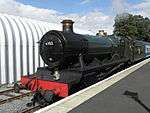 |
| Isabel |
Hawthorn Leslie |
0-6-0ST |
- |
Isabel is a 0-6-0ST by Hawthorn Leslie (works number 3437/1919) Built in 1946. These locomotives were mostly used for industrial purposes, and Isabel is an extremely powerful engine, entirely suitable for the steep gradients on the EOR and quite capable of hauling 2-3 coach trains on low-season days. It has an enlarged cab, and so is ideal for training crews and for undertaking "driver experience" courses.Arrived at the Epping Ongar Railway in 2010, Isabel is undergoing overhaul.[5][6] |
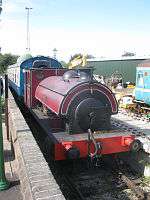 |
Diesel locomotives [7]
| Number and name |
Origin |
Wheel
arrangement |
Class |
Notes |
Photograph |
| 47635 "Jimmy Milne" |
BR |
Co-Co |
Class 47 |
47635 was built in 1964 and entered traffic in the say year, they were synonymous with Eastern Region plying their trade up and down the Great Eastern Mainline between London and Norwich. Numbered; originally D1606, it was renumbered to 47029 in 1974 and 47635 in 1986. It was Named; "Jimmy Milne" in 1987 at Glasgow Central by Mrs Alice Milne, widow of the former General Secretary of Scottish TUC. It was re-named "The Lass O'Ballochmyle" by EWS at Doncaster Works 150 Open Day in 2003. It went back to "Jimmy Milne" in preservation at the Swanage Railway in 2008. It is currently in BR Blue with yellow ends and is out of service; undergoing roof restoration.[8] |
 |
| D6729 / 37029 |
BR |
Co-Co |
Class 37 |
D6729 was built in 1961 and is resident on Epping Ongar. Following its withdrawal from main-line freight workings, it has been restored and repainted into the original 1950-1960s livery it carried when it was based at nearby Stratford shed (30A). The locomotive is popular with many as it has its original bodywork, complete with "split headcode" nose, and is one of only a few in the country. It is currently in BR Green and is Operational.[9] |
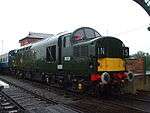 |
| 31438 |
BR |
A1A-A1A |
Class 31 |
31438 was built in 1959. Arrived on the Mid-Norfolk Railway on 24 November 2001, being delivered by road from Carlisle. On arrival at Dereham the original fault book from 31235 was found inside it, both locomotives having been stored at Upperby shed. The locomotive is one of a number fitted with electric train heating. It was delivered new to Ipswich shed as D5557, being transferred to Norwich between 1961 and 1965. It used to carry a unique livery of Brunswick Green with BR arrow symbols on all four cabsides and the numbers behind the doors.[10] It was listed for sale in late August 2011,[11] was sold to the Epping Ongar Railway by September, and left the MNR after their Autumn Gala.[12] It is currently in BR Blue and is Operational.[13] |
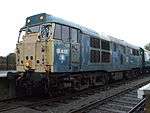 |
| 45132 "Peak" |
BR |
1Co-Co1 |
Class 45 |
45132 was built as D22 in 1961 by BR Derby works. As a new engine, D22 was allocated to 55A Leeds Holbeck shed. In the 1970s, steam heating of trains was being phased out, and it was converted to electrical train supply, and renumbered 45132. It spent most of its life allocated to Toton shed, from where destinations as far flung as St Pancras, Holyhead, Carlisle, Newcastle and Plymouth were reached, generally on Passenger workings. 5132 was withdrawn in 1987, and stored at March in Cambridgeshire. It is currently in BR Blue, Undergoing heavy overhaul.[14] |
 |
| D7523 / 25173 |
BR |
Bo-Bo |
Class 25 |
D7523 was built by British Railways at Derby in 1965 and started its career at Toton TMD before moving around various London Midland Region sheds such as Willesden, Longsight, and Crewe. It was renumbered 25173 in 1974.[15] It had been based at the Crewe Heritage Centre and on the West Somerset Railway.[16] It arrived at the railway on 7 September 2011 and will be used for engineering and ballast trains and for maintenance and testing of vacuum-braked coaches.[17] It is currently in BR Green, Undergoing heavy overhaul.[18] |
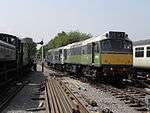 |
| 03170 |
BR |
0-6-0 |
Class 03 |
03170 was delivered to British Railways as D2170 in late 1960. It was withdrawn in 1989. This class of locomotive that has a long history of working in East Anglia, the class being allocated to Stratford, Colchester, Ipswich and Norwich depots up until the late 1980s. This locomotive has dual (air and vacuum) braking. Its claim to fame is that it was the last 03 converted and overhauled at Swindon works before they closed. It is currently in BR Blue, Operational but restricted to yard use.[19] |
 |
| 03119 |
BR |
0-6-0 |
Class 03 |
03119 was built in 1959, it is an unusual locomotive as it was modified with a "cut down" cab to enable it to work the Burry Port & Gwendraeth Valley branch, which had lower bridges. Built at BR Swindon Works and introduced in September 1959 as D2119, it was allocated to Danygraig depot. 03119 was moved to the West Somerset Railway in March 1996, where it has been kept in good working order by the Diesel and Electric Preservation Group at Williton. It now resides on the EOR as one of the shunting locomotives. It is currently in BR Blue, it is stored out of traffic.[20] |
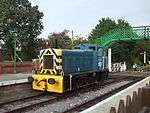 |
| D2957 / RH 512572 |
Ruston and Hornsby |
0-4-0 |
|
RH 512572 of 1965 has been restored to working order, repainted and returned to traffic, after being restored by a team of volunteers. It was built at Vulcan Works, Lincoln in 1965. It is the smallest of the railway's locomotives, with 88 hp from a 4-cylinder diesel engine, complete with an air-operated starter. It has its own charm, and is a reminder of the small shunting engines that used to toil away in rail-connected yards around East Anglia and the London Docks. It had been used in a BR track maintenance department in the Midlands and has been restored to the early BR identity of 2957, which was a sister Ruston shunting engine based at nearby Stratford works. It is currently in BR Black, it is stored out of traffic, listed for sale.[21] |
 |
| RH398616 |
Ruston and Hornsby |
0-4-0 |
|
RH 398616 of 1956 is out of service. All salvageable parts have been removed and the unit is on static display on a plinth by the main road at Ongar.[22] |
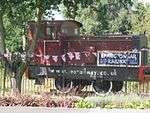 |
DMUs
| Origin |
Number |
Class |
Notes |
Photograph |
| British Rail |
Unit DMBS 51342 and DMS 51384 Set No - |
Class 117 |
The railway has the two driving cars from what was a three-car Class 117 DMU. There were 127 of this type of vehicle and they were delivered new in 1959 to Southall depot working services between Paddington and the suburbs. They continued to be based in the London area until withdrawal in the 1990s, they arrived at the Railway in 2004.Each coach has two Leyland diesel engines underneath, which drive the wheels mechanically through a fluid flywheel. The driver's cab at each end of the unit means it can be driven from either end, making it ideal when running to Coopersale, and speeding up turn-around times. The windows in the ends mean passengers in either coach get an excellent view of the line ahead or behind and also get to watch the driver in action. The unit ran in an unusual dark blue and white 'EOR' livery until 2007, when it was taken out of service by the new owner when services were suspended. The interior has been refurbished, the unit is receiving attention to the exterior bodywork. It is planned to have the unit back in service at the beginning of 2016. DMBS Undergoing extensive restoration; DMS available as coaching stock.[23] |
 |
DEMUs
| Origin |
Number |
Class |
Notes |
Photograph |
| British Rail |
Unit 60110 and 60810 Set No 205205 |
Class 205 |
The railway has a 2-car 1957 "Hampshire" Class 205 DEMU 205205. These DEMUs were once common on many commuter lines and nicknamed "Thumpers" due to the characteristic noise they produce. The "Thumper" has been brought back to the South East from the North Yorkshire Moors Railway, and has been restored and again carries passengers. It is the usual motive power for the trains towards Epping. 205205 is the only unit with a corridor connection as it was experimentally converted and modernised by British Rail. Because of this it was saved for preservation. The volunteer team at EOR has restored the unit, complete with its commuter-style interior and is now painted in former "Network SouthEast" livery. This ensures the preservation of this period of transport history and is attractive to film and TV companies who require a train of that era. It arrived at the Epping Ongar Railway in 2009. It is Out of Traffic - available as coaching stock.[24] |
 |
EMUs
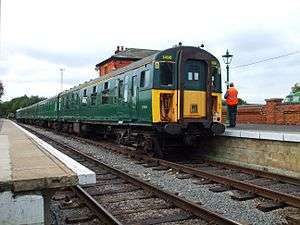
4CIG 1498 at North Weald as a four-car unit propelled by a diesel loco (just visible at the rear).
Epping Ongar Railway has an affinity with electric multiple unit (EMU) preservation, as the branch used LT's electric stock from 1957 until 1994. There was talk of the line being electrified by the LNER with overhead electrification before the Second World War intervened. Some local lines were electrified quite early on, for example to Shenfield and Southend, and the next generations of EMUs continue to work services on those lines into Liverpool Street.
While the 3rd & 4th conductor rails were removed by the new owners, the line still hosts electric style units, though without the electrification they are hauled by a diesel locomotive. Due to cost, safety issues and legislation it is not possible to re-electrify the branch.
| Origin |
Number |
Class |
Notes |
Photograph |
| British Rail |
Unit 68001 |
Class 419 / MLV |
Built in 1959, Arrived at the Epping Ongar Railway in 2016. This unit has batteries to allow it to operate away from the third rail, for conveying luggage and parcels on dockside lines. The current set of batteries were funded by the Heritage Lottery Fund. Locomotive owned by the EPB group and is currently Operational.[25] |
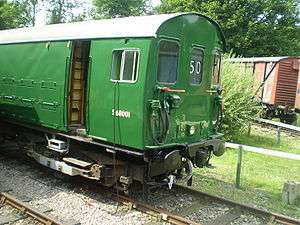 |
| British Rail |
Set 7105, coaches 70235 and 69345 |
Class 412 / 4-BEP |
Built in 1956, Arrived at the Epping Ongar Railway in 2016. This unit contains the only surviving Bep buffet car, the unit is running in the refurbished condition. The 2 motor coaches are currently at Eastleigh works for the rebuilding of the brake (guards) compartment in the original position. The trailer coaches are at the Epping Ongar Railway. The trailers are stored under restoration[26] |
- |
Carriages
Gresley Carriages [27]
The most iconic carriage design of the LNER, these lasted well into BR ownership. Finalised in 1923, the design utilised a 60ft underframe, with more traditional squared moulding and windows and wooden teak-panelled bodies. There are two examples on the EOR a Buffet car and Brake Tourist Open (BTO) examples..
| Origin |
Number |
Types |
Notes |
Photograph |
| LNER |
43556 |
Brake Third Open |
The BTO, a six-bay open saloon, has seating for up to 48 passengers, and was built in 1938, it is believed to be the last surviving 6-bay Gresley coach built to diagram D196. Arrived at the Epping Ongar Railway in 2014. Stored awaiting Restoration.[28] |
|
| LNER |
24082 |
Buffet Car |
The buffet was built in 1936. After a short stay a Quainton Road, where it was used to serve refreshments, the carriage was then moved to Chappel and Wakes Colne in 1972. Restoration had, by this stage, been commenced, but was stalled as priority was given to a BTO (which later moved to the North Yorkshire Moors Railway.) The Buffet was moved again in 2001 to the workshops at Ovington and where the coach finally received covered accommodation. The owner decided in 2010, that carriage would fit in well here, and after needing to vacate the site at Ovington, the ownership of carriage was transferred to Epping Ongar Railway Holdings Limited, on the understanding that, in due course, it would be restored to its former glory. The carriage arrived at North Weald in 2010. Stored awaitng Restoration.[29] |
|
Hawksworth Inspection Saloon
| Origin |
Number |
Type |
Notes |
Photograph |
| GWR |
80970 |
Hawksworth Inspection Saloon |
Built at Swindon just before Nationalisation in 1948, this vehicle was delivered new to Newport in South Wales. Before withdrawal in the late 1970s, it also ended up in Scotland. These types of vehicles were used by Company Directors and alike, and enabled them to review new works, re-laid track and the condition of the permanent way. Internally, it is split into two main compartments; one had a fixed drop-leaf table for drawings and documents (or perhaps even lunch) to be laid out on, whilst the other contained luxurious easy-chairs and thick carpet. These were separated by a guard's compartment, toilet and facilities for catering.The Saloons were often propelled, and thus were fitted with braking gear that could be operated by those in the coach to inform the locomotive driver to slow down or stop. Operational, painted in BR Chocolate and Cream.[30] |
|
Suburban coaches
These coaches have been acquired from the North Norfolk Railway, where they were surplus to requirements. They require some extensive interior restoration, but they are a long-term project. They are perfect for recreating a typical suburban branch line set.[31] All 3 carriages are for sale.[32]
| Origin |
Number |
Type |
Notes |
Photograph |
| British Railways |
43034 |
Non-gangwayed Lavatory Composite |
Stored awaiting Restoration, painted in Maroon. For sale. |
|
| British Railways |
53170 |
Non-gangwayed Brake Second |
Stored awaiting Restoration, painted in Maroon. For sale |
|
| British Railways |
46147 |
Non-gangwayed Second |
Stored awaiting Restoration, painted in Maroon. For sale |
|
British Railways standard steam stock (Mk.I)
The Backbone of most preserved railways, They are a durable design, representing in many ways the culmination of traditional carriage design in the UK, prior to the introduction of monocoque techniques.
British Railways (Mk.II) [42]
Non-passenger coaching stock
Southern Railway vans, etc
| Origin |
Number |
Type |
Notes |
Photograph |
| SR |
2158 |
Parcels and Miscellaneous Van |
Awaiting restoration.[48] |
|
Goods wagons
Brake vans
| Origin |
Number |
Type |
Notes |
Photograph |
| BR |
99385x |
Shark Brake Van |
Operational,Used to spread track ballast after it has been laid, as well as a guards brake van on engineers trains. It has recently undergone a full restoration, being outshopped in BR Engineer's Black.[49] |
|
| BR |
993760 |
Shark Brake Van |
Awaiting Restoration. Once restored this vehicle will also be used for engineering and demonstration freight trains, as well as infrequent brake van rides.[50] |
|
| BR |
993757 |
Shark Brake Van |
Awaiting Restoration. Once restored this vehicle will also be used for engineering and demonstration freight trains, as well as infrequent brake van rides.[51] |
|
| BR |
95803 / 955096 |
4 wheel Brake Van |
Awaiting restoration, Once a common sight at the end of every goods train, this van ended its life being used by London Transport when transferring its Heritage fleet around the Underground network. It is on loan from the London Transport Museum, and has been restored into its original BR (unfitted) light grey livery, complete with many original fittings.[52] |
|
Covered goods vans
| Origin |
Number |
Type |
Notes |
Photograph |
| BR |
4311 / 200780 |
4 wheel Non-vent Van |
Operational, These wagons were designed for the freight to and from the continent as BR updated its rolling stock. The design was introduced in 1975 and they had a number of uses and liveries, being very useful with both sliding and opening doors, enabling direct access to all parts of the vehicle. This van was used by the army, and still carries the identity "WGB 4311".[53] |
|
| GWR |
3465 |
Fruit D Van |
Operational, The Fruit 'D' vans were the last type of 'Fruit' vehicle built by the Great Western to aid some of their traffic of garden produce. The vans had additional ventilation slats in the sides to allow cool air to circulate, as well as three sets of double doors on each side and internal gas lighting, on an 18ft wheelbase. As well as the carriage of fruit, they were also found being used for express parcels traffic.[54] |
|
| BR |
783563 |
4 wheel ventilated Van |
Operational, Once numerous and used for the transportation of all kinds of parcels and merchandise. Since arriving at the railway in army livery (carrying the number WGB 4182 as pictured left), it has been restored into original BR Bauxite livery, complete with sign-written numbers.[55] |
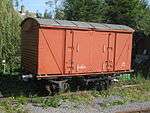 |
| LMSR |
unknown |
4 wheel ventilated Van (body only) |
Used as stores, grounded body at North Weald station.[56] |
|
Flat wagons, bolster wagons and Rail and Sleeper wagons
| Origin |
Number |
Type |
Notes |
Photograph |
| GWR |
- |
Macaw B Bogie Bolster |
Operational, Built for the Great Western Railway and designed to carry rails for the track engineers, a purpose for which it is still very useful.[57] |
|
| LT |
F 362 |
Bogie 3 Plank Open |
Operational.[58] |
|
| BR |
909074 |
Bogie Ramped Flat |
Operational, Built for carrying Army tanks (hence the telegraphic name) and latterly used by the engineers' departments for carrying heavy plant and equipment. This vehicle is very useful with its 38.5t capacity, and a team has completely restored it, repainting the frames and replacing all the wooden decking, finishing off with its lettering.[59] |
|
Ballast wagons
| Origin |
Number |
Type |
Notes |
Photograph |
| LNER |
- |
LNER 'Trout' Ballast Hopper |
Operational.[60] |
|
| BR |
DB993577 |
BR 'Dogfish' Ballast Hopper |
Operational,With doors able to spread ballast to all parts of the track (either side and down the middle), this is a useful ballast-carrying vehicle.[61] |
|
| BR |
DB 989067 |
Mermaid 4 wheel steel side tipper |
Awaiting Restoration.[62] |
|
| BR |
DB 989478 |
Mermaid 4 wheel steel side tipper |
Awaiting Restoration.[63] |
|
Tank wagons
| Origin |
Number |
Type |
Notes |
Photograph |
| PO |
87867 |
TEA' 102T Bogie Tanker |
Operational, The wagon served its life admirably moving Crude Oil across the national network, before finally ending up as a Bitumen slurry tank. This is the first 102-ton registered Bogie Tank wagon to enter preservation, and was bought in December by the National Wagon Preservation Group.[64] |
|
Cranes and other special use wagons
| Origin |
Number |
Type |
Notes |
Photograph |
| BR |
81026 |
6 wheel diesel mechanical Crane |
Stored but Movable; crane mechanism non-operational, Once used for light engineering works and in BR yellow livery, it has its runner and match trucks. The vehicle can be moved, but the crane is no longer operational.[65] |
|
| LMSR |
341895 |
4 wheel diesel Crane jib runner |
Operational, painted in BR departmental yellow.[66] |
|
| - |
PO 100 |
Bogie Ballast Hopper |
Stored awaiting restoration. Donated by the Docklands Light Railway, this is a more modern (and perhaps unique) version of the 'Dogfish'. Rebuilt from ballast hopper of regulator 77307 c. 1995 (and possibly hopper from 77334 too) This has now been sold, and is no longer at the railway.[67] |
|
| BR |
914383 |
Crane Runner |
Operational.[68] |
|
References
|
|---|
|
| Operational railways |
|---|
| | Narrow gauge | |
|---|
| | Standard gauge |
|
|---|
|
|
|
|
|
|
|
|



